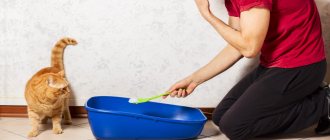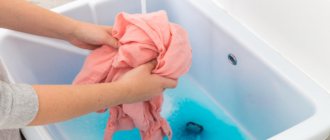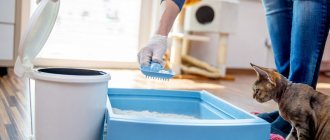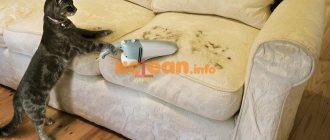A cat in the house personifies comfort, warmth and tenderness, but if mistreated by the owner, not entirely pleasant character traits may appear. Innate instincts cause the animal to express dissatisfaction and mark its territory, leaving urine stains. It doesn’t matter to him how expensive your flooring or furniture is, the main thing is to express yourself. It is difficult to remove the smell of cat urine from the floor; it contains many chemical elements.
Why is the smell so strong?
Fresh urine of kittens has almost no odor, but with the onset of puberty its chemical composition changes - hormones and felinin greatly enhance the amber.
Compared to cats, unneutered cats have three times more feline in their urine. This substance itself does not smell, but its breakdown products frankly stink. The chemical composition of urine is not constant; the smell is enhanced by many factors:
- the cat drinks little or endures it for a long time - concentration increases;
- kidney disease, bladder disease, urethritis, cystitis, genitourinary tract infections;
- with chronic stress and pain, the amber intensifies - this is a defensive reaction, this is how the pet calms itself;
- improper feeding - excess protein, metabolic disorders, a lot of fish in the diet, cheap “food” from the supermarket;
- sexual abstinence. Unlike dogs, it is not normal for cats to undergo sexual heat. When there is no partner, the body “floods” hormones to attract him.
Once the urine has been absorbed and dried, it is impossible to eliminate the lingering odor with just one cleaning. When uric acid crystals get wet, they begin to release odorous substances. It takes moisture out of the air, not to mention a new mark on top of the old one. To completely get rid of the smell of cat urine, you will have to wait for all its components to decompose or speed up this process with enzymes.
Professional help
Good store-bought products contain enzymes. Together with surfactants, enzymes decompose and do not mask the stench with fragrances. Natural ingredients are safer for animals and people, but chemistry works better. Fluorine and phosphates are undesirable in the composition.
Modern safe products with enzymes that help get rid of both the smell of cat urine and traces of vomit, excrement, and blood:
- Hartz Pet Stain & Odor Remover
- Just for Cats Urine Destroyer
- Urine Off cat and kitten
- Just for cats Stain & Odor Remover
- Odor Kill & Stain Remover
- Complete Pet Stain & Odor Remover
- Tri-bio, Odor gone, Odor kill
- Dezosan, Zoosan
It is important to distinguish products that eliminate stench from 2in1 repellent liquids - the latter are used precisely. If you flood your apartment with such a stain remover, you will most likely have the opposite effect. The cat will decide that he is being expelled from the territory and will generously move over the “enemy” scent.
Unlike ordinary household chemicals, enzymes work slowly - you need to leave the applied liquid for a while to react. The instructions indicate how to get rid of the smell of urine on a sofa, floor or carpet, whether a test is needed, precautions - for the best result, follow the manufacturer's recommendations.
Removing cat urine from shoes
When cleaning shoes from traces of cat urine, we use the following methods:
- potassium permanganate;
We first wash the product with cold water, then treat it with a weak pink solution, wash it thoroughly and dry it on the balcony.
- laundry soap;
- vinegar solution;
- iodine.
We prepare all solutions in the same way as those used for other surfaces or products. If the smell is not removed by the methods described, we use a concentrated vinegar solution, which we treat the shoes with, and then sprinkle with soda. Leave for several hours, remove any remaining powder and wipe with a damp cloth.
Traditional methods
Household chemicals and available products help if used correctly. Before use, you need to do a test on an inconspicuous area to check how the substance acts on the surface being treated. Chlorine-containing cleaners should not be used - they frighten cats. With a high probability, the pet will deliberately flood this place to kill the smell of bleach.
Red pepper, mustard, mint, coffee, and aromatic oils are often recommended. All this smells nice, partially absorbs and masks the smell, but will not help get rid of the cat “scent” completely.
Proven urine decomposition methods:
- Mix highly carbonated mineral water with liquid soap 3k1, spray generously or pour over the stain, sprinkle with salt. Sweep away the salt after a couple of hours and vacuum;
- Generously treat the area with a saturated solution of potassium permanganate, wait 30 minutes, and rinse. It is a trouble-free oxidizing agent, but its coloring properties limit its application;
- lemon juice decomposes urea and scares the cat away from its favorite place. The juice must be freshly squeezed. You can leave citrus peels nearby;
- generously sprinkle the area with baking soda and pour in peroxide. When the hissing stops, remove the liquid and add baking soda again, filling it with peroxide. Leave for a couple of hours, remove with soapy water;
- Rub a piece of glycerin soap onto the moistened surface and leave for half an hour. If it is furniture or a porous wall, go over it with a brush. Rinse off by blotting with napkins;
- Vinegar 9% helps get rid of even the old smell of cat urine from the sofa, carpet, and porous walls. Spray with a spray bottle, wait 30 minutes, rinse with water and conditioner.
Iodine does a good job of eliminating any biological amber. It needs to be added to water, a teaspoon per liter. But iodine is a permanent color, so it is not suitable everywhere.
Vinegar, soda, peroxide
A scientific approach to eliminating the most persistent stench was proposed by an American chemist who was bothered by skunks.
The method works great on textiles and porous structures, decomposing absorbed urine:
- Blot the stain with napkins, trying to collect as much liquid as possible. You can fill it with filler, gently rub it over the surface, and remove it.
- Generously pour vinegar diluted with water 1k1. Waiting until it dries completely is important, otherwise the “aroma” will remain.
- Sprinkle with baking soda. If it sizzles, the vinegar has not dried. Remove the soda, add more vinegar and wait until dry.
- If it doesn’t sizzle, spray the soda with a previously prepared mixture. For 100 ml of hydrogen peroxide, half a teaspoon of dishwashing detergent. Spray until abundant foam appears, wait 2 hours.
- Clean with regular powder or a washing vacuum cleaner. Repeat if necessary.
The oxidation reaction decomposes the urine, the components evaporate along with a heavy, intensifying “aroma” - the room is immediately ventilated.
Prevention
Buy a Wood's lamp, which will show up all cat urine stains, including splashes, clearly.
- Place the cat litter box in a secluded area.
- Treat areas of possible acts of revenge with the product in advance.
- Change the litter in the tray in a timely manner, as cats are very clean.
- Try not to punish your pet, because cats are distinguished by their touchiness.
- Neutered cats go to the litter box rather than mark their territory.
- Have your cat checked regularly by a veterinarian for kidney or urinary tract problems.
Always remember that you are responsible for those you have tamed.
Treatment of different surfaces
The easiest way to deal with hard, non-absorbent surfaces is to collect the urine, wipe with an odor remover, and rinse with water.
But cats often choose less convenient places for marks and puddles:
| Surfaces | Description of processing |
| Wood, linoleum, walls and other porous surfaces | Blot with paper napkins, trying to collect as much moisture as possible. Spray generously and blot again. Spray, brush, collect moisture with napkins. |
| Cushioned furniture | Cat urine is removed from upholstery in the same way - with paper napkins, alternately spraying and collecting moisture. The solution is injected into mattresses and armrests with a syringe little by little in several places - if urine is absorbed, it is useless to wash it from the outside. |
| Carpet | Get wet and cover the stain with toilet filler for 20 minutes, preferably silica gel. The carpet is cleaned by driving in foam with a brush, being careful not to flood the surface. Excess moisture is removed immediately. The floor under the carpet must be washed and allowed to dry, otherwise the smell of cat urine will not get rid of. |
| Clothes, underwear | Before washing, the urine is washed off well under a directed stream - the item in the basin, the basin in the bath, with the stain under the running tap for 30 minutes. Machine wash, dry. If the smell persists, soak in vinegar for an hour and wash again. |
| Air | Boil water, add citrus pieces, walk around the room. Or place saucers with crushed garlic. An ozonizer will help get rid of the smell of cat urine in your apartment. Fresheners only mask the stench. |
If a cat goes to a flower instead of a tray, the plant is transplanted into new soil. The pot is soaked in water with vinegar or potassium permanganate for a day. If urine gets on the leaves, rinse the plant in the shower. The transplanted flower is placed in another place, preferably inaccessible to the cat. If this is not possible, cover the ground with a cut plastic plate or foil.
Shoes
Sneakers and slippers are washed under running water and washed in a machine.
Shoes that cannot be washed can only be saved without delay:
- Take out the insoles and wash them, or better yet buy new ones.
- Use a napkin to collect as much urine as possible.
- Pour in silica gel, wait half an hour, shake out.
- Fill it loosely with newspaper soaked in vinegar and leave it on the balcony for a day.
- Remove the newspaper, pour loose green tea inside, wait another day.
- Clean with shoe polish.
- If that doesn’t help, treat the inside with a professional urine odor remover, put it in a bag, and wait 2 hours.
- Rinse well.
There is no need to immediately fill your shoes with water - excess moisture will only wash the urine all over the shoe. The means at hand can ruin the item, so it’s better to take expensive shoes to the dry cleaner. Before you go anywhere in your cleaned shoes, you should walk around in them at home and check to see if the “aroma” returns after wearing them.
Tray
Often this is the only source of the unpleasant smell of cat urine in the apartment. To get rid of the stench, you need to use high-quality absorbents and remove dirty litter immediately. A scratched tray needs to be replaced - the damaged bottom absorbs uric acid. The carbon filter in the roof of the toilet house does a good job of trapping stinking components.
Wash the tray with neutral solutions without fragrances - a strong smell can scare away the pet, forcing it to relieve itself past the tray. Every day the container is rinsed with a shower over the toilet, using as hot water as possible. Potassium permanganate or antibacterial liquid soap is suitable for disinfection. But it is better to use special cleaners - Beekeeper, Faithful Friend, Nature's Miracle litter box.
Choosing a cat litter box
Odor retention also depends on the type of tray. What types are there and what to choose?
1. Regular trays, which can be sold together with a grill for ease of cleaning. Cats have no problem entering such a toilet, but they can scoop some of the dirty litter onto the floor.
2. Closed, in the form of houses. These retain odor better and prevent granules from scattering. But some cats are afraid to go into closed houses.
3. Dry toilets for cats are a whole structure with cartridges, reusable granules, and other elements. The disadvantages are the dimensions and high cost.
Impact on the cause
Uncleanliness is one of the most negative aspects of having a cat in the house. Puddles on the carpet, wet corners, stains on the sofa can outweigh all the good emotions from communicating with your pet. The only way to get rid of the stench once and for all is to teach your cat cleanliness.
You just need to find the reason that encourages your pet to leave puddles and eliminate it:
- changes - a new sofa, renovation, change of regime, a new family member. Cats are very conservative. Not all changes can be undone, but you can always support and reassure. More communication, games, gatherings together - distractions from a stressful situation;
- The fight for territory will not get rid of the smell of urine, since the cat’s claims will force the pet to increasingly mark the area to be washed. We need to find the cause of the conflict - a family member is offending, there is a new pet in the house, lack of attention. The solution is to make it clear that the cat is loved and is safe here;
- dissatisfaction with the tray, the place chosen for it, the filler. It is important to analyze recent events. Perhaps they changed the air freshener or moved the laundry basket - every little thing matters in this delicate matter;
- illness, injury change behavior and habits - an always clean pet can demonstratively stain the table, the owner’s lap, or pillow. This is a request for help, a demonstration of a painful condition;
- sexual instinct - only castration will help here. If this is unacceptable, it is worth discussing the issue again with your veterinarian. Pets that do not participate in breeding do not require abstinence torture.
Fact from zoologists: animals do not know how to take revenge. If the owner thinks that the cat is marking out of harm, he simply does not understand the motives for her behavior. A veterinarian or an experienced breeder will help you figure it out.
Saving flowers
A cat is a wonderful animal that gives us warmth and comfort. It’s great if this sweet creature is not only beautiful, but well-mannered. What to do when your cat constantly gnaws on your favorite violet or breaks flower pots? It is clear that he needs to be educated. If you just recently got a kitten who does not understand how to behave properly in a new home, you should take measures to save the flowers:
- Place all the flowers as high as possible so that the kitten cannot reach, go to the toilet and throw the flower on the floor;
- As a rule, cats are partial to soil and love to dig it and throw it out of the pot - this is an animal instinct. The main thing here is to nip in the bud all the cat’s attempts so that this does not become his habit. Therefore, if you notice an animal’s attempts to move towards a pot rather than a tray, call out to it in a raised voice so that it understands the prohibition.
- You can grease the walls of the pots with lemon juice.
- Temporarily wrap the pot with material, and soon the cat will lose interest in the flowers.
- Watch for the animal and spray it with water so that the cat understands: rummaging in the pot means being splashed.
- Give the cat a replacement for a house plant - special cat grass. They love to feast on it to cleanse the stomach of fur. In specialized stores you can buy grains that are easy to germinate and give to cats, especially since they can be grown all year round.
- Place fir cones in flower pots.
- To teach your cat to defecate in a litter box rather than a flower pot, spray the container with a cat repellent.
- If none of the methods help, simply discard the flower.











